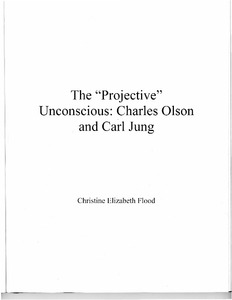| dc.description.abstract | Charles Olson ( 1910-1970), writing the bulk of his most influential works in the late forties through mid sixties, is an American poet who gained fame as a teacher in the Black Mountain College, a successor of Ezra Pound, and a predecessor for the L=A=N=G=U=A=G=E movement. Just like Jung, Olson is very much interested in interdisciplinary work, referring to himself as both poet and historian (Butterick ix). He is a historian, however, in the most complex sense of the word. Olson is simultaneously a scientist, a linguistic anthropologist, a philosopher, and, of course, a poet. All of his historical and poetic endeavors aim at revealing the complex and innermost workings of both the human mind and natural environment as microcosms of a greater universe -- the "human" universe, as he fittingly describes in his 1951 essay, "Human Universe." Olson gained immediate popularity for his poetic manifesto, "Projective Verse," which argues for poetry as an "open field" and his uses of shorthand. Olson's open field poetics, stating that word location on the page of poetry is just as important as the word itself, is deeply interested, like Jung, in energy. In Olson's 1951 essay, "The Gate and the Center," he describes a poem literally as a transfer of energy from the writer to the reader. In order to conserve this force without weakening the high-energy construct of the poem, Olson begins to use a new brand of short-hand language in his works. The ampersand replaces the common conjunction it references, and vowels are dropped from smaller words. All of his shorthand tactics help reinvent the Poundian idea of the ideogram as language, forging words with more meaning and, of course, more energy. . . . This thesis begins with the complicated history and ideas that Olson shares with Jung. It subsequently addresses the goals and themes of Olson's early works . . . and how they very readily map on to Jungian thought. Ultimately, I argue that Olson is thoroughly Jungian, even in his early works, because of his treatment of Jungian instruments of language, change, tradition, symbols, and balance. Finally, I relate all of Olson's early works to an acknowledged Jungian later work, "Proprioception," to prove formal, symbolic, and thematic similarity between the Jungian and the supposedly non-Jungian. [From Introduction] | en_US |
| dc.rights | This material is made available for use in research, teaching, and private study, pursuant to U.S. Copyright law. The user assumes full responsibility for any use of the materials, including but not limited to, infringement of copyright and publication rights of reproduced materials. Any materials used should be fully credited with the source. | en_US |
